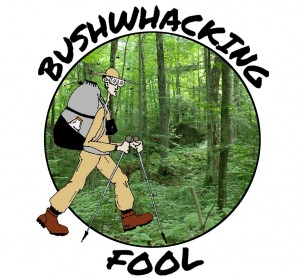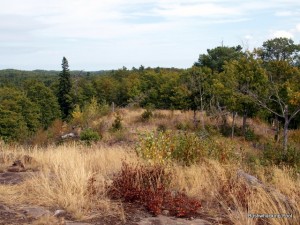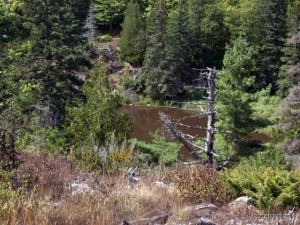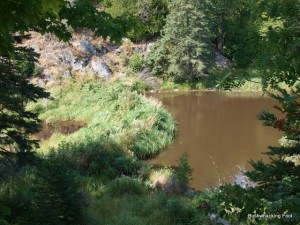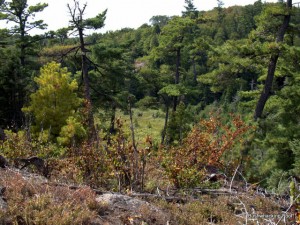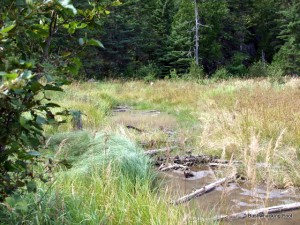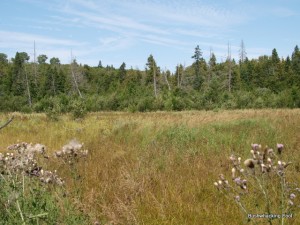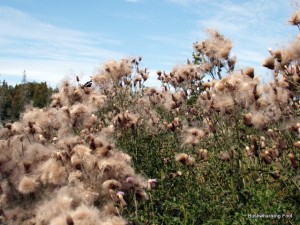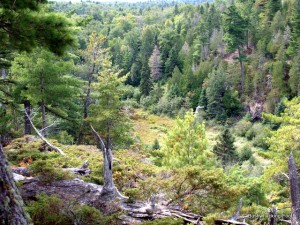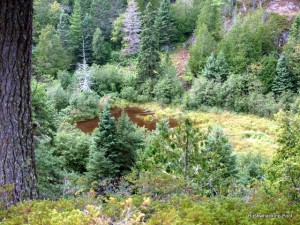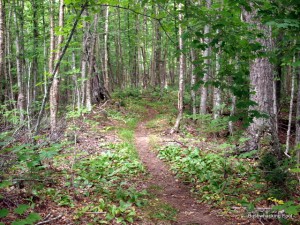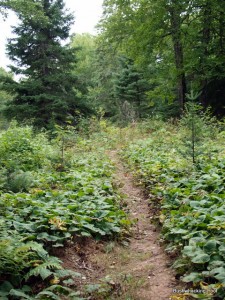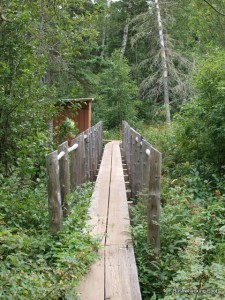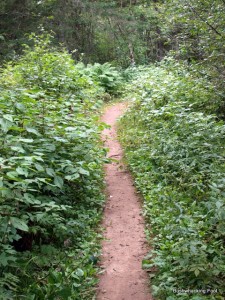The constant ups-and-downs of the Minong Ridge Trail works up quite an appetite. And with a resupply package soon to arrive in Windigo (or so I surely hope), almost anything in my rapidly shrinking food bag is fair game.
First up is a peanut butter and blackberry jelly sandwich, on a piece of multigrain round bread. The bread is fairly small, leaving plenty of room for dessert. A strawberry Kettle Valley fruit snack, Endangered Species dark chocolate bar, and a Mountain House dehydrated ice cream sandwich (surprisingly delicious) do nicely. And the Gatorade Fruit Punch packet mixes into my Gatorade water bottle, serving as the last of my fluids for the remainder of my day’s hike.
While finishing my sandwich, a hiker stops to chat on his way north. According to him the weather during the second week of my trip is supposed to be very nice, with almost no chance of rain. The only downside is the cooler weather for the next few days, with lows in the 40’s on Monday. Brrrr, now that’s cold! Especially when I am only carrying my summer clothing, and sleeping bag.
View Day Six, Part Two in a larger map
Before moving on, he asks me to tell the rest of his lagging party to keep moving and catch up to him when he stops for lunch. I agree and wish him a great hike. As he hikes away, leaving me once again alone with my own thoughts, I wonder how well his instructions are going to go over with the slower members of his party. A led zeppelin, anyone?
Section Stats:
Date: September 3, 2011
Length: 4.1 miles (10.4 total daily miles; 46.8 total trip miles)
Difficulty: Moderate (due to length and many ups-and-downs)
The wildlife does not want to be completely left out of my lunchtime experience either. While eating my dessert, I notice a large horntail wasp on a low, limb of a tree. While scrambling for my camera, the darn wasp vanishes. Soon after, I hear rustling in the leaves behind me, but regardless of how many times I look, I fail to find anything. A phantom rodent, perhaps? Or just one clever enough to outwit a tired hiker. How does it know to stop moving whenever I am looking in its direction?
As I am packing up my stuff, and preparing for the second half of my hike to Windigo, three hikers come trudging up from the south. After verifying the previous hiker is within their group, I pass along his request, followed quickly by their snickering and mockery directed at him. They appear slightly overburdened, and their goal of getting to North Lake Desor appears a bit optimistic. Especially given the rather portly physique of one, and the fact another is carrying his shoes due to blisters. Good luck with that!
Soon after the hikers are on their way, I gather up the rest of my stuff, and once again commence my journey toward Windigo. The trail continues its previous trends, as it weaves over a series of rocky ridges, separated by short stretches of sugar maple forest. No views are in sight, as the rocky ridges are surrounded by forest.
After several open ridges, the trail hugs a cliff with frequent views of a large, muddy pool down below. The trail descends rapidly to the southern shore of the muddy, beaver pond, where it crosses on a grassy, ancient beaver dam. The dam winds through the narrow valley between two rises, dividing the open water into two different pools. Unfortunately, the trail goes straight up the far side, which is steep, rocky and devoid of trees.
After climbing up away from the open water, the trail returns to a series of open and rocky ridges surrounded by an encroaching forest. Just when I thought I had seen the last of Lake Superior from the Minong Ridge, the trail climbs to an open ridgeline where the lake and a far-off Canada spring into view. The sight does not last long, as the trail once again follows along a cliff with a wide, open herbaceous-filled wetland far below.
This ridge is much higher above the wetland than the last one encountered. Unlike the previous wetland, this one is devoid of open water; instead the wetland is a sea of grass and other assorted herbaceous vegetation. The trail is very dusty, clogged with rocks and tree roots as it descends rapidly toward the edge of the wetland. Many large white pines line the trail as it descends all the way to the edge of the wetland.
The trail begins to cross the wetland on corduroy, until it mounts another ancient beaver dam. The dam is covered in thistles, each one covered in buzzing bees, butterflies and other assorted insects. I move across the dam carefully, trying not to anger the many stinging insects, as they may be testy as they gather what little nectar is still available such late in the summer. What little open water exists is on the far side of the wetland from where I entered it. Several small, shallow, muddy pools lie scattered along the dam here.
After crossing the wetland, the trail climbs suddenly again to an open, rocky ridgeline, where another view of Lake Superior and the Canada appears just above the tree line. A series of open ridges follow with short stretches of sugar maple forest separating them.
The trail pulls up alongside the edge of another high cliff, with an open wetland far below. Yes, again! At this point, I am starting to think I am stuck in some type of hiking Groundhog Day, where I am cursed to repeat the same stretch of trail over and over for all eternity. Is this the punishment for the rock throwing incident at McCargoe Cove? Am I the sacrifice the island demanded?
Once again, rocks, loose sandy soil, roots and white pines are prevalent along the trail here. Many views down to the open water below are available, giving me a slight feeling of vertigo as I proceed. Although the trail descends rapidly, it never crosses the wetland on a beaver dam this time. Instead, the trail just keeps going along the eastern side of the ravine, as the wetland gets narrower and narrower.
The open pine forest transitions quickly along the descent to a completely closed-canopied sugar maple and yellow birch forest. This forest has less ground vegetation; a state totally opposite of most of the forests observed on Isle Royale thus far. I get a very central New York vibe from this forest, which is in stark contrast with the forest up higher on the ridge.
Finally, the trail descends to the small stream and crosses it on a couple of large rocks. The trail climbs immediately up the next bank, turns west and continues through the hardwood forest, with the ground falling off steadily to the south. The trail slowly descends into another ravine, crosses another small stream and ascends into a yellow birch dominated forest.
Soon after entering a more open-canopied mixed forest, apparently due to wind damage based on the number of downed logs and young saplings, the trail arrives at the intersection with the East Huginnin Cove Trail. Only 1.8 more miles to Windigo! I heard Huginnin Cove is quite beautiful, too bad there is likely no time for it on this trip.
After a brief stop to rest my very sore, and most-likely blistering, feet, I get back on the trail to try to finish up this lengthy hike. It has been a long day, almost 3 PM and Washington Creek Campground (0.3 miles north of Windigo) cannot come soon enough, as far as I am concerned.
The trail is mainly level, through a mixed forest with a high amount of yellow birches, before descending to the West Huginnin Cove Trail intersection. Now there is only 1.2 miles to Windigo. The trail is mostly open here, with a thick ground cover of herbaceous vegetation and tree seedlings.
The trail continues to descend steeply, with the sound of rushing water from Washington Creek heard well before it is within sight. The trail crosses the creek on an extensive two plank bridge, which makes a sharp turn at about its mid-point across. High posts lie along the piers of the bridge; wooden cross-beams creating a guiderail, obviously to prevent spent hikers from tumbling over the edge while crossing.
Washington Creek is a much larger stream than any previously encountered on Isle Royale. There is a good reason for it; its floodplain includes much of the northwestern corner of the island. In fact, every stream, wetland and marsh crossed during today’s hike feeds directly into this creek. I wonder if the water flowing under me on the bridge this very minute was the same water crossed on one of the many beaver dams earlier today.
An old rock wall stretches through the creek, its height just inches above the current water level. A gap in this wall acts as a weir, letting water flow through unobstructed. Is this part of the gauging station indicated on the National Geographic map? There is no equipment measuring the water here, as far as I can see.
A small wooden shed stands along the mid-section of the bridge. This is obviously part of the gauging station, where samples of water quality and flow are taken on a regular basis. According to DuFresne’s book, the data from this station are used as a control, and compared to those from urban areas to examine the effect of human activity on water quality.
The trail climbs steeply out of Washington Creek’s basin, making a sharp turn to the southwest. The forest is more coniferous now, with spruces and balsam firs dominating. My map indicates there is less than a mile to Washington Creek Campground now. Thank God!
After crossing a series of small plank bridges, the trail arrives at the intersection with the Greenstone Ridge Trail. Another short rest ensues. Despite being so close to the campground I can nearly smell it, my sore feet demand it. As does my bulging bladder. I must be completely hydrated given the amount of times I have to stop and relieve myself. It is hard to believe, since I have been nursing my last remaining beverage since lunch.
There is now only 0.3 miles to Washington Creek Campground, and about an equal distance to Windigo beyond that. Before moving on, I take a quick look up the Greenstone Ridge Trail. Since I am planning on taking the Feldtmann Lake Trail on my way back to Rock Harbor initially, this nearly 6-mile section of the Greenstone will be skipped.
The last three tenths of a mile are fairly open, with much alder shrubs and grassy vegetation bordering the trail. When I spot the campground sign for the group campsites, there is a renewed spring in my step, all the way to the side trail to the individual campsites.
Finally, after my longest day’s hike on Isle Royale thus far, I arrive at the Washington Creek Campground. Now I just need to find a nice shelter in which to spend the next two nights as tomorrow is a much needed rest day. A reward my feet greatly appreciate.
Affiliate Disclaimer: Some links within this blog post may send you to a retailer website. If you chose to purchase any product at that site at that time the author will receive a small commission. These commissions provide compensation for the author’s time and effort necessary to provide the content at the Bushwhacking Fool.
